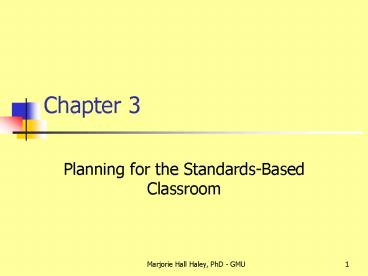Planning for the Standards-Based Classroom - PowerPoint PPT Presentation
1 / 21
Title:
Planning for the Standards-Based Classroom
Description:
Chapter 3 Planning for the Standards-Based Classroom Setting the Stage Effective planning requires that the teacher fully understand the learning goals and can ... – PowerPoint PPT presentation
Number of Views:66
Avg rating:3.0/5.0
Title: Planning for the Standards-Based Classroom
1
Chapter 3
- Planning for the Standards-Based Classroom
2
Setting the Stage
- Effective planning requires that the teacher
fully understand the learning goals and can
predetermine learning foci, lesson sequencing,
activities and projects, and appropriate teaching
methods and strategies.
3
Planning Managing Interactive Instruction
- Well-planned lessons are critical and should
- Connect past experiences with new knowledge
- Promote active use of language
Past experiences
New Knowledge
4
Course and Program Planning
- Planning generally includes
- Central goals and purposes of the course or
program - Local and state standards
- Course content
- Organizing sequencing resources
- Assessment
- Course program evaluation teacher
self-assessment student self-assessment
5
Course and Program Planning
- Important terminology in curriculum development
- Goal aim or purpose of instruction
- Objective (outcome) The learner will be able
to.. - Framework state document that describes goals
and standards to be met
6
Program Models
- Bilingual immersion (90/10 or 50/50)- academic
instruction given in L1 and L2 for K-12 - Developmental bilingual education academic
instruction half a day in each language K-6 - ESL or ESOL- All academic instruction in English
- ESL content or sheltered instruction
- Elementary self contained for 1-2 yrs., then to
mainstream - Secondary teachers with dual certification in
ESL/content
7
Program Models
- ESL pull out most implemented, most , least
effective - Immersion content-area classes in L2
- Inclusion ESL teacher and classroom teacher
plan and teach together - Mainstreaming ESL teacher determines when
student has proficiency to attend all English
classes - Monitoring ESL teacher monitors students close
to exiting
8
Program Models
- Sheltered English- specialized form of immersion
- Submersion- students attend regular content-area
classes with no special L2 instruction - Transitional bilingual education ½ day in L1
½ day in L2 changing to all L2 in 2-3 years - Two-way bilingual education language minority
and majority students taught together in same
class
9
Program Models
- Foreign Language Program Models
- FLES a sequential, articulate program which
teaches the four skills - FLEX emphasizes culture rather than
communication limited in scope and time - Immersion(partial/total) students learn content
subjects in target language
10
The Role of Textbooks Other Materials in
Planning for Content-Based Instruction
Textbook Analysis Selection
- Visual appeal
- Organization/Activity sequence
- Cultural information
- Activities
- Diverse learning styles
- Integration of language forms
- Allowance for creation of language, knowledge and
creation of meaning
- Freedom from bias
- Use with CLiDES
- Ideas for alternative
- assessments
- Alignment with local,
- national standards
- Authenticity of text
- Use of technology
11
The Nature Role of Culture in Planning
- Teachers must
- Meet national, state and local standards while
providing a curriculum that is inclusive of all
learners
12
Unit Planning
- Assessment
- Provides achievable and measurable unit
objectives based on a standards-based curriculum - Is ongoing
- Can be formal or informal
13
Unit Planning
- Planning for Diverse Learner Needs
- Include a wide array of activities to cover
students varied learning styles - Closely follow IEPs
- Be aware that cultural differences may appear as
behavior/learning problems
14
Planning Across Proficiency Levels
Differentiated Instruction
- Three aspects of differentiating
- Content concepts, principles, skills
- Process activities that allow students to learn
- Products projects which allow students to
demonstrate and extend knowledge - Remember every class and every student is
unique!
15
Daily Lesson Planning
- Planning Phase
- Identify
- Performance objectives
- Content of each lesson
- National, state, and local standards
- Ask yourself these questions about your students
- what do you want them to know?
- what do you want them to be able to do?
- what measurements can be used for assessing
growth, progress, achievement and performance vs.
peers?
16
Daily Lesson Planning
- Teaching Phase
- Setting the Stage introduce topic access
background information - Providing Input vocab, grammar, content
- Guided Participation tasks in pairs, groups
- Extension culminating activity
- Methods/Approaches/Strategy appropriate to
objectives, students - Other Activities follow-up activity,
assessment, homework, technology, materials,
closure
17
Daily Lesson Planning
- Reflection Phase
- What worked well
- What did not work well
- What you will do differently
- How the plan can be improved
- One important thing that you learned
18
Daily Lesson Planning
- Other Considerations
- Time will the lesson work well in the morning
as well as the afternoon? - Place seating arrangement, equipment placement,
location of print materials, use of bulletin
boards - Locating other resources in additional to
textbook, add Internet, magazines, newspapers,
films, CD-ROMs, videos, student sourced materials
19
Daily Lesson Planning
Daily Lesson Planning
- The Lesson Plan Format
- Beginning teachers should use templates provided
for specificity and detail - Experienced teachers can use a shorter version
20
Planning Alternative Scheduling Formats
- Block Scheduling offers in-depth instruction,
extended learning sessions - 4 x 4 model (Straight Block, 90/90)
- Four 90-min. classes/day, 5 days/week for one
semester new classes the following semester - Rotating Block Schedule (Flexible Block, A-B
Block Schedule, 8-Block Schedule) - Four 90-min classes on A days 4 different 90-min
classes on B days
21
Effective Planning Teaching Strategies
- Strategies for Teaching on Block Scheduling
- Plan a wide variety of activities
(student-centered and teacher-centered) - Address multiple learning styles and
intelligences - Work smarter act as facilitator during
cooperative learning, group and pair activities,
learning centers - Use a pacing guide for long-term planning






























